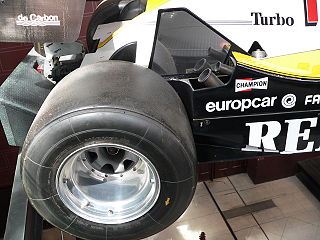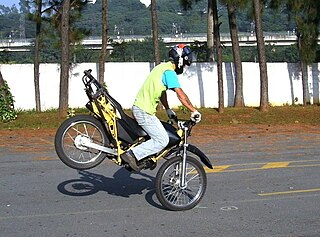
Groove wander, similar to Tramlining, is a lateral force acting on a vehicle's wheel resulting from the combination of rain grooves (grooves cut into roads to mitigate hydroplaning in light rain conditions) and contoured deformations in the road surface upon which the wheel runs. [1]

Tramlining is the tendency of a vehicle's wheels to follow the contours in the surface upon which it runs. The term comes from the tendency of a car's wheels to follow the normally recessed rails of street trams, without driver input in the same way that the train does. The same effect is sometimes called Nibbling.

Aquaplaning or hydroplaning by the tires of a road vehicle, aircraft or other wheeled vehicle occurs when a layer of water builds between the wheels of the vehicle and the road surface, leading to a loss of traction that prevents the vehicle from responding to control inputs. If it occurs to all wheels simultaneously, the vehicle becomes, in effect, an uncontrolled sled. Aquaplaning is a different phenomenon from when water on the surface of the roadway merely acts as a lubricant. Traction is diminished on wet pavement even when aquaplaning is not occurring.
When the contact patch of the tire does not form to match the contours of the road surface the stiff tire edges tend to ride on and be guided (or tramlined) by the rain grooves within the surface contour. This force is greater than the contact patch can counter and the resultant force is delivered to the wheel hub and axle, pushing the car laterally. When all four wheels are acted upon in this way, the vehicle can experience rapid forces occurring from side to side and corner to corner (similar to encountering wind gusts, only from all four directions instead of just one).

Contact patch is the portion of a vehicle's tire that is in actual contact with the road surface. It is commonly used in the discussion of pneumatic tires, where the term is used strictly to describe the portion of the tire’s tread that touches the road surface. The term “footprint” is used almost synonymously. Solid wheels also exhibit a contact patch which is generally smaller than the pneumatic “footprint”.

A tire or tyre is a ring-shaped component that surrounds a wheel's rim to transfer a vehicle's load from the axle through the wheel to the ground and to provide traction on the surface traveled over. Most tires, such as those for automobiles and bicycles, are pneumatically inflated structures, which also provide a flexible cushion that absorbs shock as the tire rolls over rough features on the surface. Tires provide a footprint that is designed to match the weight of the vehicle with the bearing strength of the surface that it rolls over by providing a bearing pressure that will not deform the surface excessively.

A wheel hub assembly (WHA), also referred to as hub assembly, wheel hub unit, wheel hub bearing, etc., is a automotive part used in most cars, passenger vehicles, and light and heavy trucks.
A mismatch between tire design and vehicle weight, or vehicle suspension design, or simply wheel alignment can all contribute to how severe the effect is. Tire tread pattern can also cause, with straight grooved tires more susceptible to groove wander than diagonal or zig zag threads.

Suspension is the system of tires, tire air, springs, shock absorbers and linkages that connects a vehicle to its wheels and allows relative motion between the two. Suspension systems must support both road holding/handling and ride quality, which are at odds with each other. The tuning of suspensions involves finding the right compromise. It is important for the suspension to keep the road wheel in contact with the road surface as much as possible, because all the road or ground forces acting on the vehicle do so through the contact patches of the tires. The suspension also protects the vehicle itself and any cargo or luggage from damage and wear. The design of front and rear suspension of a car may be different.

Wheel alignment, sometimes referred to as breaking or tracking, is part of standard automobile maintenance that consists of adjusting the angles of wheels to the car manufacturer specifications. The purpose of these adjustments is to reduce tire wear, and to ensure that vehicle travel is straight and true. Alignment angles can also be altered beyond the maker's specifications to obtain a specific handling characteristic. Motorsport and off-road applications may call for angles to be adjusted well beyond "normal", for a variety of reasons.







